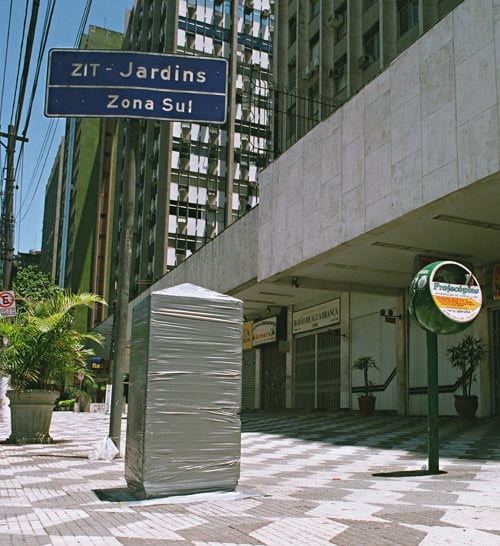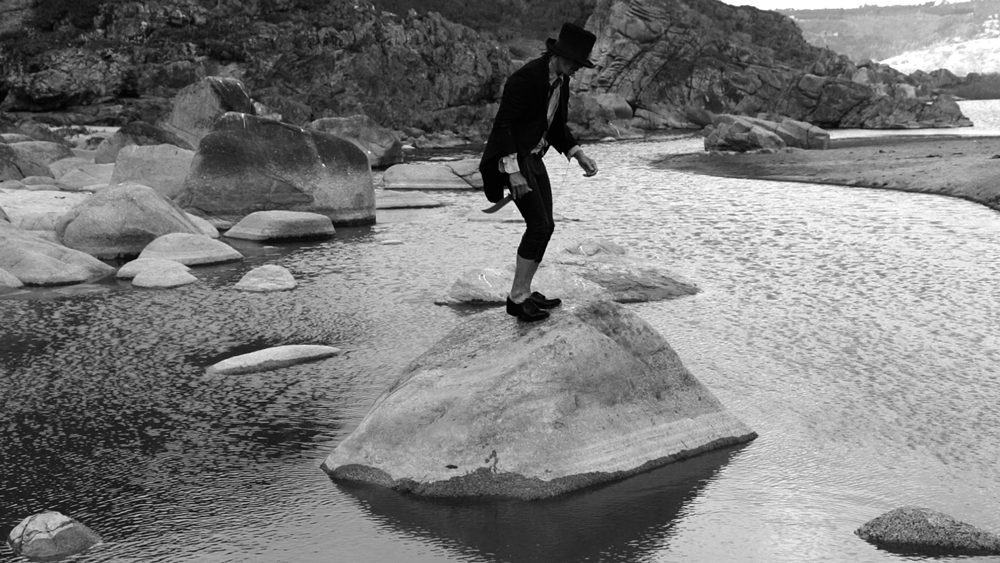
© » KADIST
Francis Alÿs
Drawing & Print (Drawing & Print)
This series of small drawings is executed with varying materials—pen, ink, colored pencil, charcoal, and masking tape—on architect’s tracing paper. Alÿs often executes such sketches in preparation for his performances, videos, and larger two-dimensional bodies of work. As the first visual representations of his ideas, they capture his thinking processes at the raw conceptual stage and allow us to gain a deeper understanding of his larger works.

© » KADIST
Taysir Batniji
Fathers #18 and Fathers #27 is part of a series of photographs and videos made in recent years in Gaza. Batniji addresses the representation of the over-identified human and physical space with the geographical and political situation in the region. He distinguishes himself from the fictions that have been previously created in the Middle East and offers a quieter and more retained vision of the of the intertwining tensions and oppositions in this area.

© » KADIST
Mikhael Subotzky
At the halfway point along South Africa’s Highway N1, running from Cape Town to Johannesburg, sits the small town of Beaufort West. The 1,200-mile highway joins the northern provinces of the country to the south cuts through. Beaufort West becomes the main strip of the township, whereby the thousands of commuters passing through are thus forced to witness the town’s squalid social and economic condition.

© » KADIST
Juan Araujo
Drawing & Print (Drawing & Print)
Many of Araujo’s works depict reproductions and Libro Ponti II is a recreation of a book on Italian architect Gio Ponti. Ponti designed the Villa Planchart a private, modernist house in Caracas, Venezuela, which at the time it was built in 1956, reflected the emergence of a class increasingly globalized, both culturally and economically. Araujo’s replica of the book thus refers to the role and visibility of Venezuela in circuits of global cultural production.
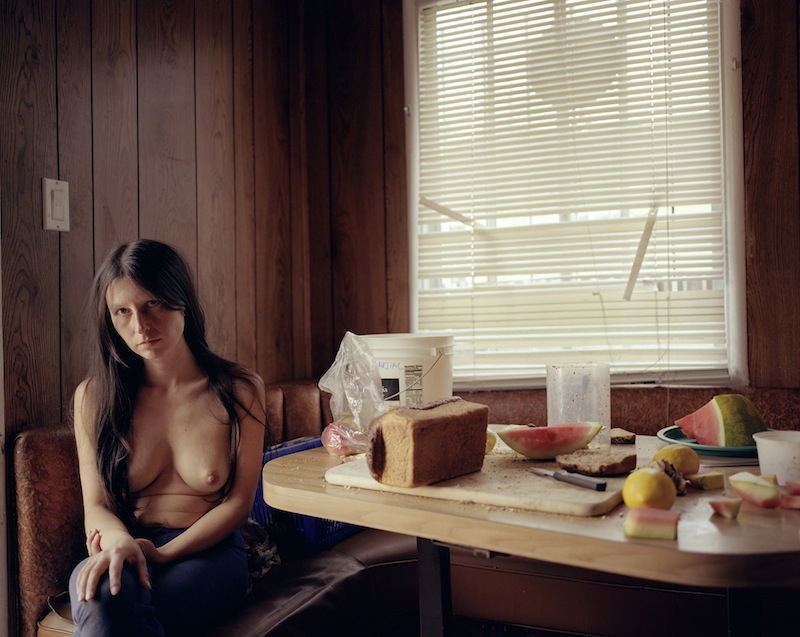
© » KADIST
Pascal Shirley
Gypsy shows an ambivalent scene, in which broken blinds and its unsmiling subject are balanced with the stilllife plentitude of watermelon slices and the beautifully lit nudity of the sitter. The room seems messy and in disrepair, but simultaneously romanticizes the scene. The fruit and the sitter suggest a robustness in contrast with the mise-en-scene.

© » KADIST
Dread Scott
Drawing & Print (Drawing & Print)
This screen-print by Dread Scott titled Imagine a World Without America shows a map without the landmass that is the USA, as if the continents have drifted, or as if it never existed in the first place. Artist Dread Scott’s work is founded upon challenging “American patriotism as a unifying value,” and as such he claims that it is necessary to “burn the US Constitution (an outmoded impediment to freedom), and position the police as successors to lynch mob terror.” Perhaps one must imagine a structurally different world to produce new and freer modes of thought. While not explicitly related to Afro-Futurism, one of the key sub-genres of science-fiction and related thought is speculative revisionism; asking ‘how would the world be different if X never happened?” This modest work is a call to our daily imaginary, an invitation to zoom out to the scale of the global human condition, and implicitly America’s role in trade, war, cultural exchange, and the spread of western values.

© » KADIST
Raymond Pettibon
The five works included in the Kadist Collection are representative of Pettibon’s complex drawings which are much more narrative than comics or cartoon. The images allude to recurring topics, such as the superhero (present both in Untitled Superman and No title without the comics ), a book cover (his literary sources), or a mushroom cloud. Inspired by the writings of William Faulkner, Daniel Defoe, Gustave Flaubert, Marcel Proust, and James Joyce, Pettibon’s sophisticated, witty drawings combine image and text to explore the gamut of American popular culture.

© » KADIST
Felix Gmelin
In Untitled (after Paul Schultze Nuremberg’s Kunst) (2006), from a larger series of diptychs, Gmelin addresses the notion of entartete kunst ( “Degenerate Art”) . Each diptych juxtaposes a portrait of a person considered to be mentally handicapped with a painting that was branded by the Nazi regime as degenerate. Gmelin’s source for these images is Kunst und Rasse (“Art and Race”), a book by Paul Schultze Naumburg published in 1928.
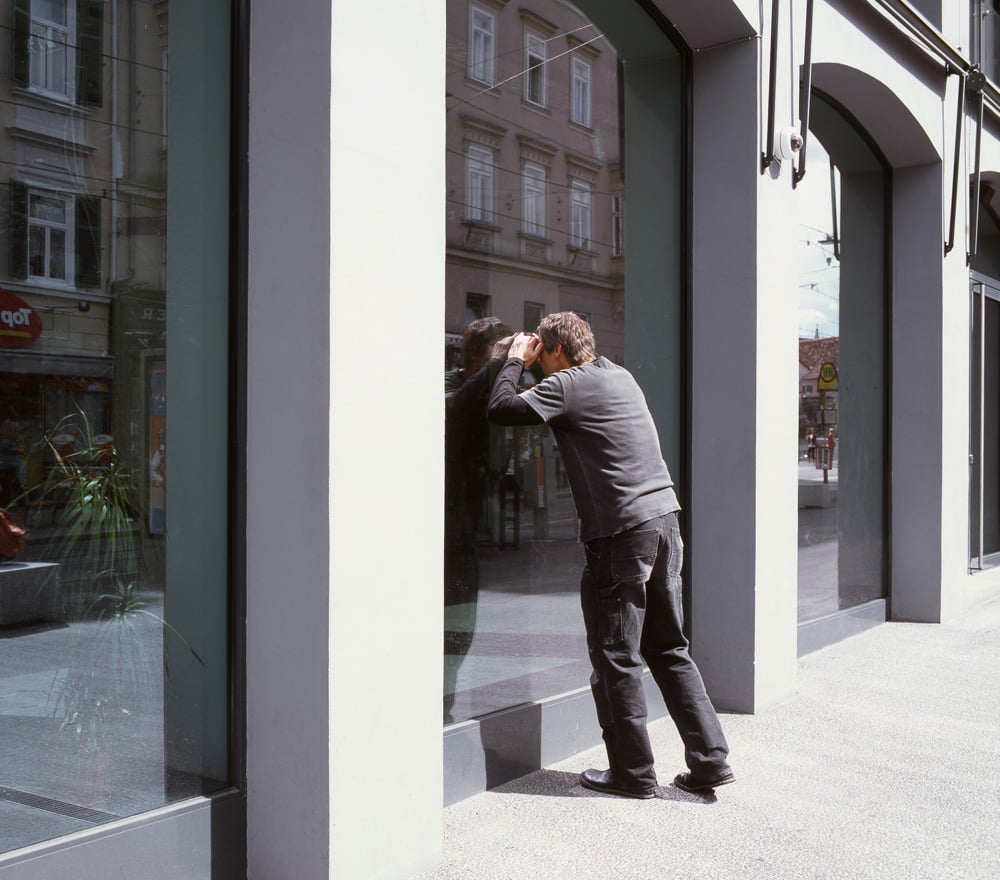
© » KADIST
Roman Ondak
“A man wanders near the windows of a gallery, situated adjacent to the street. He occasionally gazes through windows into the gallery but never enters.” Passersby are numerous since these windows are by a tram stop on a busy street. It is surprising to note how few of them take any notice of this man peering repeatedly through the slightly tinted glass into an empty meeting room with no distinctive signs to be seen.

© » KADIST
Ruijun Shen
In Seven Deadly Sins (2006), Shen utilizes abstraction to produce complex topographies of color that evoke associations with violently tumultuous landscapes. Streaks of blue and burgundy paint scatter across a peach colored silk backdrop, dripping into rough floral and botanical forms. At once both diffuse and dense, Shen’s compositions feel both expansive and contained, the colors overlaid atop another with a seemingly free spontaneity that belies more ordered and considered deliberation.
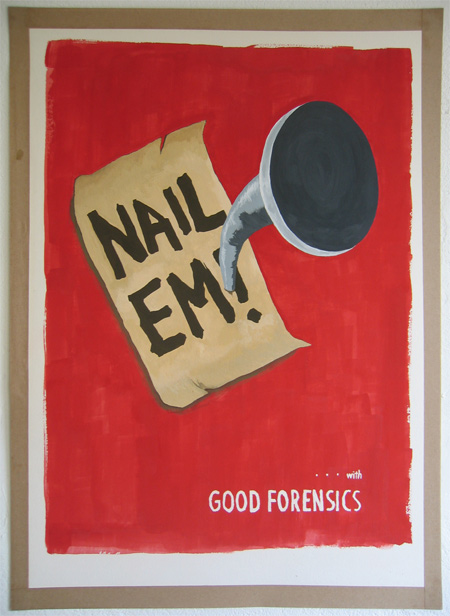
© » KADIST
Mike Cooter
Drawing & Print (Drawing & Print)
Forensic Poster was first realized in 2006 and reactivated in 2011; its making consisted of the artist visiting the London School of Criminology and corresponding with the interim director there in order to reproduce a poster by memory. This piece of work is symptomatic of Cooter’s projects which are often arduous enterprises littered with pitfalls, since they imply prospecting and collaborating with third parties whose will determine the success of the project. Forensic Poster consists of a letter, emails and a gouache which translates the artist’s attempt to recreate a poster glimpsed at in one of the study halls of the London Police Department of Forensic Medicine.
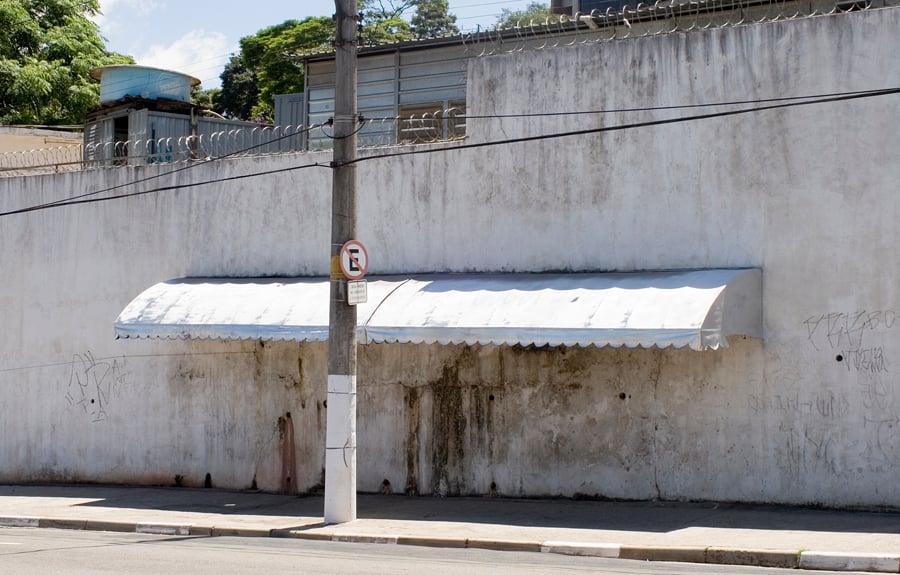
© » KADIST
Marcelo Cidade
This series of photographs reflects Marcelo Cidade’s incessant walks or drifting through the city and his chance encounters with a certain street poetry like the Surrealists or Situationists before him. He captures incongruities or everyday simplicity and highlights their suggestive power. The composition and framing of these interventions specially emphasizes the object of interest and the humor of the context.

© » KADIST
Anna Molska
Perspective was filmed during a residence in northern Poland. The film is preceded by a series of photographs made ? ?in her studio.

© » KADIST
Xiaoyun Chen
In the video work Drag, a man in a dark room pulls on the end of a rope. In midst of sounds of heavy breathing, the camera presents alternating scenes of a man and the shadow of a man wearing a long, pointed hat cast against a wall. Insinuating a sinister mood, the man and the shadow struggle to control the scene through alternating tugs and releases of a rope.

© » KADIST
Laurent Montaron
This film refers directly and fictionally to one of the first media dramas: the burning of the Zeppelin aircraft LZ 129 Hindenburg as it landed in New York in 1937. The power of these images, which were widely diffused in the press, had a profound haunting impact on people’s consciousness. This mode of transport – both futuristic and obsolete – crystallizes a collective imaginary which was fed by cinematic, literary and mythological fiction as Barthes would put it.

© » KADIST
Hiraki Sawa
Hako (2006) depicts a mysterious and dystopic landscape where the world becomes flat: distance between different spaces, depth of field and three-dimensional perceptions are canceled. Interiors of a Victorian doll’s house, a rippled seascape, a palm tree forest, and a gravel seashore are superimposed, morphing into each other. The hermetic narrative is charged with psychological and mythological aspects.

© » KADIST
Prinz Gholam
Ein Ding Mehr , or ‘one more thing,’ is part of a long-term collaborative performance series by artists Wolfgang Prinz and Michel Gholam, which consist of the pair embodying an array of material through holding various poses for extended periods of time. As the artists perform each gesture, we see them gaze on the preparatory drawings, which act as an instructional score of sorts. The drawing itself, besides featuring carefully drawn sketches of each position, also contains a list of the source material that inspired them: a scene from Pier Paolo Pasolini’s film, Salo, Eugène Delacroix’s Pietà, and a reference to a monument by Auguste Rodin among others.
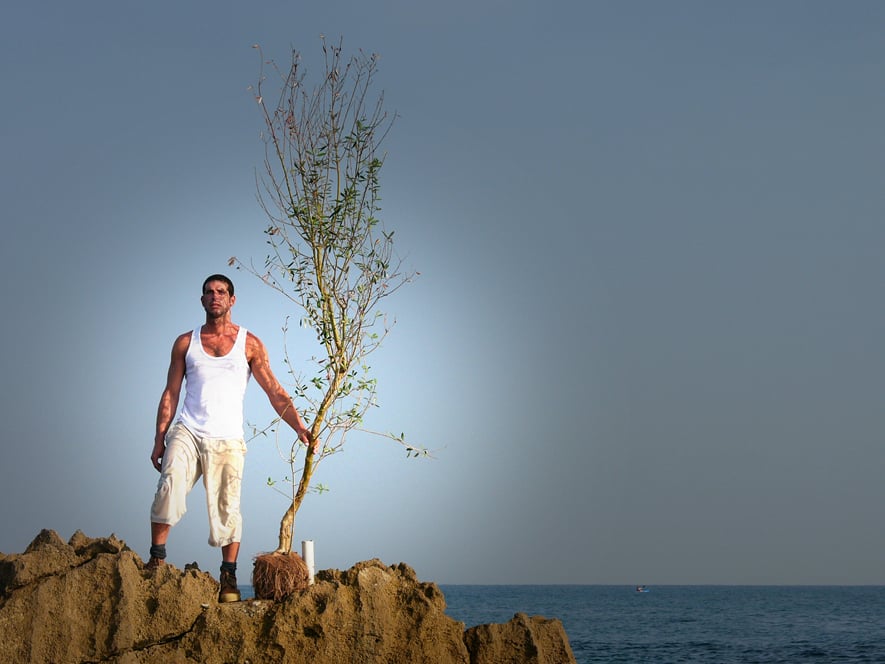
© » KADIST
Yael Bartana
Yael Bartana’s video work A Declaration was shot in southern Tel Aviv, on the visible border between that city and Jaffa. It begins with the sound of waves and the image of the Israeli flag that fills the entire screen. This is followed by the whirring sounds of a helicopter.

© » KADIST
Laetitia Sonami
Although at first the work Sounds of War presents itself with a degree of playfulness and humour, a close inspection reveals its painful undertone. The sound installation by Laetitia Sonami is comprised by a series of toilet plungers retrofitted with speakers that audiences are encouraged to engage with. As viewers interact with the modified domestic objects, placing them over their ears, a soundtrack plays audio sourced by the artist from Youtube videos, which feature the haunting voices of women and children in several war zones (Srebrenica, Darfur, Fallujah, Gaza and Iraq).

© » KADIST
Qing Zhang
603 Football Field presents a soccer game played inside a small student apartment in Shanghai. Installed like monitors fed by surveillance cameras, the videos present a voyeuristic entry into a private space, where two teams of men are scurrying around a bed, a desk, and some shelves in to score a goal, represented by a kitchen at one end and bathroom at the other. The game is furnished with complete uniforms, a referee, and a midfield line.

© » KADIST
Benoît Maire
The piece consists of sculpture of 10 elements, among them: a globe, a picture of a gorilla, a chair, scrabble letters, 3 glasses of black ink, a book whose title is illuminated by the beam of a 8mm projector, a pair of boots, etc. The display is a collection of selected objects chosen in response to the reading of a text by Alain Badiou (the first chapter of the seminar “Le réel est l’impasse de la formalisation; la formalisation est le lieu de passe en force du réel” from February 4, 1975). The elements are a visual way to question the transposition of an idea into reality.
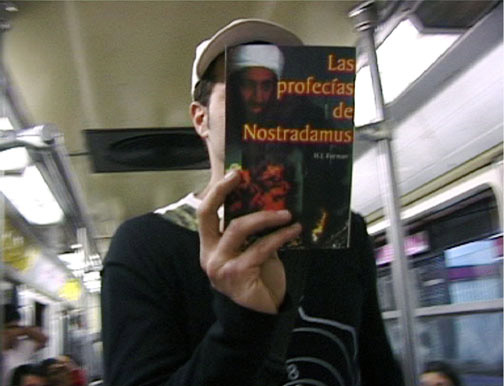
© » KADIST
Christoph Draeger
In his performative action Subterranean Doomsday Vendor , Draeger positions himself in the subway system of Mexico City, as part of the common occurrence of bootleg media vendors. His contribution lies in dissemination of prophecy as he tests the public’s reactions to the types of content and media which can be circulated in such common spaces.

© » KADIST
Chen Shaoxiong
After engaging primarily with video and photography for more than a decade, Chen turned to painting to explore the issue of urban change and memories—both personal and collective. This “return to origin” reveals an interesting critical reflection on the interactive relation between outside change and internal reflection, and the possibility for more experimental approaches that revive “traditional media.” For Ink Diary , Chen recorded his daily life and impressions within a rapidly-changing urban setting in ink wash paintings which he then turned into an animated film. The complex result of this simple process is both highly innovative and reflective of modernization.

© » KADIST
Gareth Moore
Uncertain Pilgrimage is an ongoing project in which Moore draws from his unplanned travels in recent years. Many of the pieces are found objects and discarded materials that he has transformed into tools and eccentric prop-like sculptures to help him on his journeys. Map (from Uncertain Pilgrimage) is one such object that could be a metaphor for the whole project: a simple empty paper map that has no location written on it.

© » KADIST
Minerva Cuevas
Drawing & Print (Drawing & Print)
During her research on primitive currencies and cultural cannibalism, Cuevas came across the Donald Duck comic book issue “The Stone Money Mystery,” where Donald goes on a quest to find missing museum objects. Cuevas’s America (2006) is a wall painting of a comic Donald Duck wallowing in a heap of gold coins, alluding to Mexico’s postrevolutionary mural tradition. The mural’s background is one of the earliest illustrations of flora and fauna in the American continent, juxtaposed with a reference to America as having bountiful natural resources available to be exploited, and the historical use of comics as ideological tools.

© » KADIST
Joachim Koester
Physical and mental exploration have been founding elements in Joachim Koester’s research for several years. While exploration was mainly a matter of geography during the 19th century, the 20th century brought the mental exploration of our unconscious, triggered by the discovery of psychoanalysis. Koester is interested in documenting minor events, forgotten by History, in order to reintroduce them into collective memory.
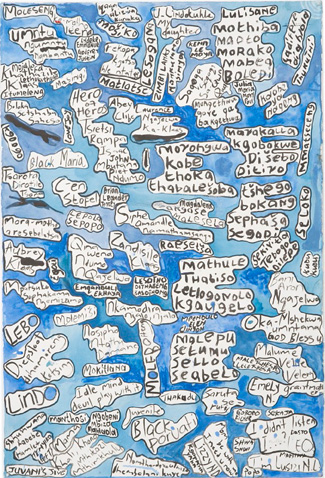
© » KADIST
Moshekwa Langa
Drawing & Print (Drawing & Print)
In “Untitled II (Mapping text)”, 2009, Langa abstracts language in an attempt to change the familiar into the absurd. With reference to comic speech bubbles, Langa combines in a sea of blue gouache a series of nuanced references to identity and politics with “Black Maria” alongside nostalgic and subtle phrases such as “mom be with me, I need u now” and “I didn’t listen.” Through this gathering of references “Untitled II (Mapping text)” forges a poetic and vulnerable site to engage with his personal experiences while simultaneously suggesting the senseless structure of language. This work resonates to larger world of art, politics and popular culture through layering assorted references, piling up meanings that are cryptic and ambivalent, yet resonant with multiple interpretations.

© » KADIST
Edgar Arceneaux
Drawing & Print (Drawing & Print)
Untitled (Wheelchair Drawing) is a ten-foot photo transfer of the image of a wheelchair with burning embers in its seat. In 2006, it was included in the exhibition, Alchemy of Comedy…Stupid at Artpace in San Antonio where Arceneaux explored the links between the medieval practice of alchemy and contemporary comedy. However, his particular image of the wheelchair is tragic, since it refers specifically to the comedian Richard Pryor, who became temporarily wheelchair-bound after being severely burned from drug use, and died prematurely of a heart attack in 2005.
Xiaoyun Chen
- location: Hangzhou, China
- year born: 1971
- gender: male
- nationality: Chinese
- home town: Hubei Province, China
Julio Cesar Morales
- location: San Francisco, California
- year born: 1966
- gender: male
- nationality: Mexican
- home town: Tijuana, Mexico
Pascal Shirley
Pascal Shirley’s photographs portray a California of beaches, music festivals, families, and hipsters wandering through the hills...
Prinz Gholam
Prinz Gholam is a Berlin-based artist duo consisting of Wolfgang Prinz and Michel Gholam...
Dread Scott
Dread Scott is an interdisciplinary artist who for three decades has made work that encourages viewers to re-examine cohering ideals of American society...
Claire Fontaine
Claire Fontaine is a Paris-based collective, founded in 2004...
Taysir Batniji
The work of Taysir Batniji, a Palestinian artist born in Gaza shortly before the 1967 war and the Israeli occupation, is tainted with manifestations of impermanence and itinerancy, belonging and uprooting, personal memories and historical events...
Minerva Cuevas
- location: Mexico City, Mexico
- year born: 1975
- gender: female
- nationality: Mexican
- home town: Mexico City, Mexico
Roman Ondak
- location: Zilina, Slovenská Republika
- year born: 1966
- gender: male
- nationality: Slovakian
Ruijun Shen
Ruijun Shen conceptualizes her painting-based practice as a form of extended meditation and a means of processing tensions between time and space in the world around us...
Gareth Moore
- location: Berlin, Germany
- year born: 1975
- gender: male
- nationality: Canadian
- home town: Matsqui, Canada
Felix Gmelin
With a degree in painting and inspired by so-called institutional criticism, Felix Gmelin is interested in the possibilities of painting as a form of resistance and its direct relation to a form of socio-political reality...
Carlos Amorales
- year born: 1970
- gender: male
- nationality: Mexican
- home town: Mexico City, Mexico
Colectivo Tercerunquinto
Colectivo Tercerunquinto develops work related to the urban, the boundaries between public and private space...
Mikhael Subotzky
Mikhael Subotzky’s (b...
Chen Shaoxiong
- location: Beijing
- location: Guangzhou, China
- year born: 1962
- gender: male
- nationality: Chinese
- home town: Shantou, Guangdong Province, China
Raymond Pettibon
- location: Hermosa Beach, California
- year born: 1957
- gender: male
- nationality: American
- home town: Tucson, Arizona
James Welling
- location: New York, New York; Los Angeles, California
- year born: 1951
- gender: male
- nationality: American
- home town: Hartford, Connecticut
Laetitia Sonami
Based in San Francisco, Laetitia Sonami is a French-born electronic composer, performer, sound installation artist and educator...
Laurent Montaron
Using a variety of media – photography, film, sound, installation, sculpture – Laurent Montaron’s work ‘renders an image’ in Mélancolia (2005) the magnetic band of an echo chamber endlessly loops and unwinds to become a hypnotic serpentine line...
Bruno Pacheco
Painting is at the center of the artist Bruno Pacheco’s practice...
Edgar Arceneaux
- location: Los Angeles, California
- year born: 1972
- gender: male
- nationality: American
- home town: Los Angeles, California
Juan Araujo
- year born: 1971
- gender: male
- nationality: Spanish
- home town: Caracas, Venezuela
Felipe Dulzaides
Felipe Dulzaides studied drama at the Instituto Superior de Arte of Havana and received a MFA in New Genres from the San Francisco Art Institute...
Yael Bartana
- location: ‘Afula, Yisra'el
- year born: 1970
- gender: female
- nationality: Israeli
Joachim Koester
- year born: 1962
- gender: male
- nationality: Danish
- home town: Copenhagen, Denmark


